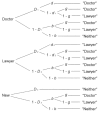Influences of Source - Item Contingency and Schematic Knowledge on Source Monitoring: Tests of the Probability-Matching Account
- PMID: 21603251
- PMCID: PMC3095109
- DOI: 10.1016/j.jml.2010.09.001
Influences of Source - Item Contingency and Schematic Knowledge on Source Monitoring: Tests of the Probability-Matching Account
Abstract
The authors investigated conditions under which judgments in source-monitoring tasks are influenced by prior schematic knowledge. According to a probability-matching account of source guessing (Spaniol & Bayen, 2002), when people do not remember the source of information, they match source guessing probabilities to the perceived contingency between sources and item types. When they do not have a representation of a contingency, they base their guesses on prior schematic knowledge. The authors provide support for this account in two experiments with sources presenting information that was expected for one source and somewhat unexpected for another. Schema-relevant information about the sources was provided at the time of encoding. When contingency perception was impeded by dividing attention, participants showed schema-based guessing (Experiment 1). Manipulating source - item contingency also affected guessing (Experiment 2). When this contingency was schema-inconsistent, it superseded schema-based expectations and led to schema-inconsistent guessing.
Figures





References
-
- Alba JW, Hasher L. Is memory schematic? Psychological Bulletin. 1983;93:203–231.
-
- Batchelder WH, Batchelder E. Meta-cognitive guessing strategies in source monitoring. In: Dunlosky J, Bjork RA, editors. Handbook of Metamemory and Memory. New York, NY: Psychology Press; 2008. pp. 211–244.
-
- Batchelder WH, Riefer DM. Multinomial processing models of source monitoring. Psychological Review. 1990;97:548–564.
-
- Batchelder WH, Riefer DM. Theoretical and empirical review of multinomial process tree modeling. Psychonomic Bulletin & Review. 1999;6:57–86. - PubMed
-
- Bayen UJ, Murnane K, Erdfelder E. Source discrimination, item detection, and multinomial models of source monitoring. Journal of Experimental Psychology: Learning, Memory, and Cognition. 1996;22:197–215.
Grants and funding
LinkOut - more resources
Full Text Sources
